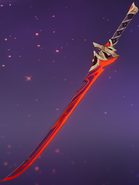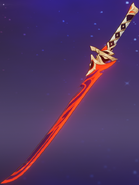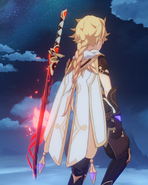Kagotsurube Isshin is a 4-star sword obtained after completing Kaedehara Kazuha's Story Quest Acer Palmatum Chapter: Act I - A Strange and Friendless Road.
Ascensions and Stats[]
| Ascension Phase |
Level | Base ATK |
2nd Stat (ATK) |
|---|---|---|---|
| 0✦ | 1/20 | 42 | 9% |
| 20/20 | 109 | 15.9% | |
| Ascension Cost (0 → 1) | |||
| 1✦ | 20/40 | 135 | 15.9% |
| 40/40 | 205 | 23.2% | |
| Ascension Cost (1 → 2) | |||
| 2✦ | 40/50 | 231 | 23.2% |
| 50/50 | 266 | 26.8% | |
| Ascension Cost (2 → 3) | |||
| 3✦ | 50/60 | 292 | 26.8% |
| 60/60 | 327 | 30.4% | |
| Ascension Cost (3 → 4) | |||
| 4✦ | 60/70 | 353 | 30.4% |
| 70/70 | 388 | 34.1% | |
| Ascension Cost (4 → 5) | |||
| 5✦ | 70/80 | 414 | 34.1% |
| 80/80 | 449 | 37.7% | |
| Ascension Cost (5 → 6) | |||
| 6✦ | 80/90 | 475 | 37.7% |
| 90/90 | 510 | 41.3% | |
Total Cost (0 → 6)
 150,000 Mora
150,000 MoraGameplay Notes[]
- This weapon is intended to have only one Refinement Rank, which is confirmed by the Refine page of weapon's Details menu.
Preview[]
Description[]
A long blade of the color of blood, upon which has been bestowed the name Isshin. It is remarkably sharp and vividly ominous.
It is said that this blade can easily cleave through a porous bamboo basket and the water within it before the latter can even leak out.
People often say that within the body of every blade rests a blade-spirit.
Then it is natural to assume that a blade forged by the Tatarigami is dwelled by a demon of malice.
The renowned blade Kagotsurube Isshin is forged by the swordsmith Akame Kanenaga, who failed to become the head blacksmith.
Though forged by the hand of an Inazuman swordsmith, this blade was not made in the nation of thunder and Jade Steel, but in a snow-covered land in the far north.
If beheld in the moonlight, the blade's hamon would look as if it were flowing, like the blood and tears of a wayfaring wanderer.
"The 'Tatarigami' is pure malice by nature. It bears resentment against mortal desire."
"Swords are merely instruments of misfortune. Without wickedness, they will not birth slaughter. Without hate, they would never know the taste of blood."
"'Isshin' is the stillness of the mind, free of distractions. This purity of desire empowers the swordsmith to forge tirelessly."
"But by this token, resentment against living beings is the metal from which a blade that kills shall be forged."
In their frenzied passion to practice "Isshin," the Akame School had always pursued the forging of a killer blade that could reach the extremes of lethality.
As such, the body and mind of the members of the Akame School were often withdrawn and short-spanned, their hearts venomously graven.
The blades made by the Akame School were keen indeed, but many of them had some evil within that ultimately led to the school itself being regarded by the authorities as "undesirable."
For this reason, the Akame School's position as the leader of the Isshin Art, passed down from Mitsunaga, did not last three generations before being rescinded by the authorities.
After that, Akame Kanenaga was involved in the Case of the Eccentric and committed treason.
This led him to change his name and leave for a snow-covered nation in the far north, to make a humble living in the land ruled by imperious ice.
The only wish of the deceased Kaedehara was to see the Isshin Art celebrated by those who understood a sword's beauty.
But the swordsmith, the blade, and the Tatarigami were all tools and titles for people to wield...
"I spent half of my life in pursuit of the vanity that is the Isshin Art, it only turned out that I became another 'Kaedehara'!"
"Ah, what's done is done. My only hope is that the sword born in the ice and frost will not be as weak as its useless title..."
The Kaedehara Clan were master swordsmiths whose works best symbolized Masagomaru's style; whilst the Niwa Clan were humble and diligent, skilled in clay tempering.
In their frenzied passion to practice "Isshin," the Akame School had always pursued the forging of a killer blade that could reach the extremes of lethality.
As he passed away amidst the vast snow, the man only wished to forge a renowned blade with which to restore the name of Kaedehara and win back the recognition of the people...
Lore[]
Akame Kanenaga, a skilled swordsmith who fled Inazuma to Snezhnaya when Scaramouche was executing the destruction of the Isshin Art of the Raiden Gokaden, forged Kagotsurube Isshin out of regret. He used the power of the Tatarigami to infuse the blade with its own consciousness and, on his deathbed, told the blade of his wish to show Inazuma that the Isshin Art could still produce magnificent blades and was still worthy of the Raiden Shogun's trust.
The blade then began his long journey back to Inazuma. However, the hatred that is intrinsic to the Tatarigami warped the blade's drive into a desire to rival the gods at any cost, and he began to use humans as tools in his journey by possessing them until they were no longer of use before discarding them.
By the time the blade arrived in Inazuma, his power was greatly diminished. During the events of Kaedehara Kazuha's Story Quest Acer Palmatum Chapter: Act I - A Strange and Friendless Road, he encounters Kazuha and is forced to face his lack of power as well as the truth of his own corruption by the source of his consciousness. He then decides to control Kazuha, with Kazuha's consent, to forge himself anew at the cost of his own consciousness so that Kazuha may use it in his studies, with the hope that the Isshin Art will one day produce a blade that will place the Isshin Art back in high regard by the Raiden Shogun. Before the blade's consciousness fades away, he reveals his name, Kagotsurube Isshin, to Kazuha.
Gallery[]
Trivia[]
- The sword is named after Kagotsurube (籠釣瓶), a haunted sword that appears in the kabuki play Kagotsurube Sato no Eizame (Japanese: 籠釣瓶花街酔醒). In the play, Kagotsurube is owned by Jirozaemon, a wealthy man from the country who falls in love with a courtesan. The courtesan has a lover who is hostile to Jirozaemon, which leads to a love triangle and eventually bloodshed when Jirozaemon uses his sword to kill the courtesan (and other characters, depending on the version of the play).
- The name Kagotsurube (籠釣瓶) itself is explained as "a well bucket (釣瓶 tsurube) made from a bamboo basket (籠 kago)." Just as no water would remain in such a bucket, no drops of blood would remain on the sword's sharp edge.
- The sword in the play is connected to legends of the 16th century swordsmith Muramasa. Because of their exceptional sharpness, Muramasa blades were favored by the early generations of the Tokugawa shogunate. When misfortune struck the Tokugawa clan, it was often associated with Muramasa blades not because they were cursed, but simply because most of their samurai used them. Later generations came to view Muramasa blades as sinister items, capable of bringing curses against the shogunate. Kabuki dramas from the 18th and 19th centuries, including Kagotsurube Sato no Eizame, reflect this later belief, depicting them as cursed swords with demonic powers that create bloodlust in their wielders. This particular image of Muramasa blades has carried on through Japanese popular culture since then.
- This weapon was originally announced as "Cursed Blade" and continued to be called such on the official Genshin Impact Website throughout Version 2.8, but it is never referred to as such in-game.
- Kaedehara Kazuha is seen wielding this sword in his Genius Invokation TCG character card.
Other Languages[]
Kagotsurube Isshin
| Language | Official Name |
|---|---|
| English | Kagotsurube Isshin |
| Chinese (Simplified) | 笼钓瓶一心 Lóngdiàopíng Yīxīn |
| Chinese (Traditional) | 籠釣瓶一心 Lóngdiàopíng Yīxīn |
| Japanese | 籠釣瓶一心 Kagotsurube Isshin |
| Korean | 카고츠루베 잇신 Kagocheurube Itsin |
| Spanish | Kagotsurube Isshin |
| French | Kagotsurube Isshin |
| Russian | Кагоцурубэ Иссин Kagotsurube Issin |
| Thai | Kagotsurube Isshin |
| Vietnamese | Kagotsurube Isshin |
| German | Kagotsurube Isshin |
| Indonesian | Kagotsurube Isshin |
| Portuguese | Kagotsurube Isshin |
| Turkish | Kagotsurube Isshin |
| Italian | Kagotsurube Isshin |
Isshin Art Clarity
| Language | Official Name | Literal Meaning |
|---|---|---|
| English | Isshin Art Clarity | — |
| Chinese (Simplified) | 澄澄一心传 Chéngchéng Yīxīn-chuán | |
| Chinese (Traditional) | 澄澄一心傳 Chéngchéng Yīxīn-chuán | |
| Japanese | 澄・一心伝 Chou - Isshinden[!][!] | Clarity - Isshin Art |
| Korean | 투명한 잇신의 기술 Tumyeonghan Itsin-ui Gisul | Transparent Art of Isshin |
| Spanish | Claridad de la técnica Isshin | Clarity of the Isshin Technique |
| French | Clarté de l'Art Isshin | Isshin Art Clarity |
| Russian | Ясность искусства Иссин Yasnost' iskusstva Issin | Isshin Art Clarity |
| Thai | Isshin Art Clarity | — |
| Vietnamese | Tinh Hoa Isshin | |
| German | Klarheit der Isshin-Schule | Clarity of the Isshin School |
| Indonesian | Isshin Art Clarity | — |
| Portuguese | Claridade da Arte Isshin | Clarity of the Isshin Art |
| Turkish | Berrak Isshin Sanatı | Clear Isshin Art |
| Italian | Chiarezza dell'arte Isshin | Isshin Art Clarity |



























































